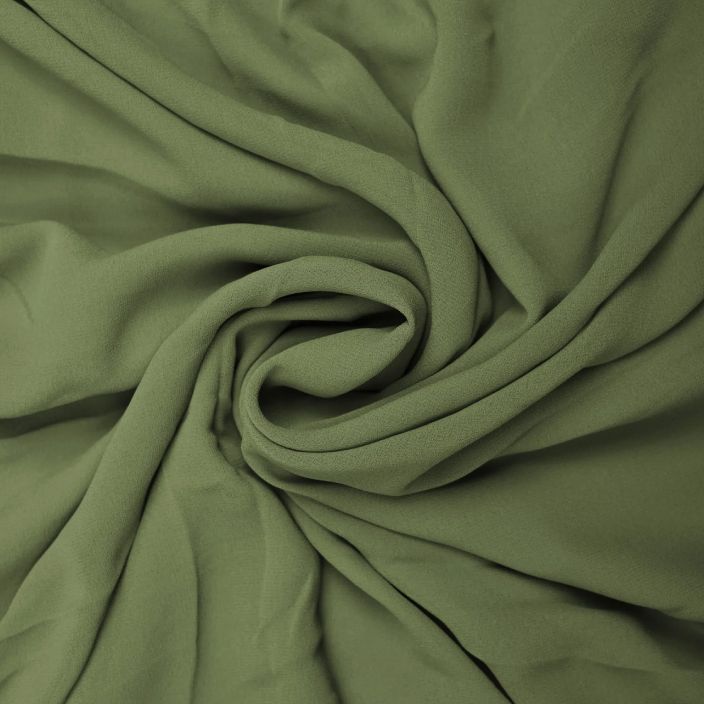For best prices and early deliveries, WhatsApp us at. 918488070070

Georgette
Georgette is loved for its light, breezy feel and slightly crinkled look, making it a go-to for fancy fashion and decor. Its soft, flowy drape and gentle shine create elegant outfits and delicate touches for homes, perfect for stunning evening dresses, bridal looks, and chic decor. The allure of georgette fabric lies in its soft, slightly grainy texture, which combines breathability with a sophisticated bounce. Pure georgette material offers a luxurious, silky hand-feel, while synthetic blends enhance durability and affordability, catering to diverse fashion needs. Ideal for warm climates, georgette material’s lightweight nature ensures comfort, making it perfect for dresses, sarees, and scarves. Its versatility supports vibrant prints, embroideries, or minimalist designs across various types of georgette fabric. Sustainability depends on Georgette’s fibre composition. Pure georgette fabric, derived from silk, is biodegradable but resource-intensive, requiring significant water and energy for silkworm cultivation. Synthetic georgette material, often polyester-based, offers scalability and lower costs but is less eco-friendly due to its non-biodegradability. The fabric’s dye-absorbing properties enable a wide colour palette, from soft pastels to bold hues, making it ideal for festive, bridal, or casual applications, enhancing the appeal of georgette fabric. Georgette extends beyond apparel to decor, with georgette material used in sheer curtains, table overlays, and event drapery, adding an airy elegance. Its ability to layer effortlessly makes it suitable for voluminous or fitted silhouettes, from intricate couture to breezy prêt. As fashion embraces lightweight luxury, different types of georgette fabric, including pure georgette material and synthetic blends, remain timeless.
The Making of Georgette
The production of georgette fabric is a delicate process that transforms fibres into a lightweight, sheer textile, celebrated for its crinkled texture and elegant drape. Whether crafted from silk for pure georgette fabric or polyester for synthetic blends, creating georgette material involves precise spinning, weaving, and finishing techniques, resulting in a versatile textile used across various types of georgette fabric for fashion and decor.
The process begins with fibre selection. Silk, the foundation of pure georgette material, is harvested from silkworm cocoons, requiring careful extraction to yield fine, continuous filaments. Synthetic fibres, such as polyester, are used for more affordable types of georgette fabric, offering durability and scalability. These fibres are spun into fine, high-twist yarns, a critical step to achieve georgette fabric’s signature crinkled texture. High-twist spinning ensures the slight bounce and strength needed for pure georgette fabric’s delicate weave.
Weaving employs a plain weave structure with tightly twisted yarns, creating the characteristic sheer, crinkled surface of georgette material. Unlike heavier textiles, the open weave maximises breathability, making it ideal for layered designs in dresses or scarves. Looms are calibrated for precision to avoid snags, particularly for pure georgette fabric, which demands careful handling to maintain its subtle sheen and fluidity across types of georgette fabric.
Post-weaving, georgette fabric undergoes finishing. Scouring removes impurities, while chemical treatments enhance the crinkled texture of synthetic blends. Dyeing achieves vibrant or subtle hues, supporting intricate prints or embroideries for various types of georgette fabric. Degumming silk enhances softness, while calendering polishes the surface for a refined sheen, ensuring georgette material’s elegance for fashion applications.
Pure silk georgette is eco-friendly and biodegradable, but its intricate production process makes it more expensive. On the other hand, synthetic georgette is more affordable and easier to produce, though it’s less sustainable. Careful quality checks ensure its signature crinkled texture sustains, giving georgette its light, flowy charm that’s perfect for stylish clothes and home décor.
Utility
Georgette fabric’s airy lightness and the durability of synthetic georgette material suit warm climates, while its fluid drape supports layered or fitted designs, making georgette fabric ideal for elegant and practical applications.
Georgette’s lightweight, sheer texture and soft crinkle make it a popular choice in women’s fashion. Its fluid drape is ideal for sarees, evening gowns, and bridal lehengas, often worn during festive and formal occasions. The fabric’s subtle sheen adds glamour to kurtas and anarkalis, while its breathability suits warm weather. Embroidered georgette elevates wedding outfits with intricate designs, and printed georgette brings vibrant patterns to dresses and scarves, blending modern and traditional styles.
In menswear, georgette is used for lightweight kurtas and Indo-Western sherwanis, offering a refined, comfortable look. Subtle embroidery on evening shirts or scarves adds sophistication, especially for cooler seasons.
In home décor, georgette’s airy quality and soft shimmer help add elegance to any space. Sheer georgette curtains filter light, creating a warm, inviting glow in living rooms or bedrooms. Its delicate drape is ideal for canopy beds or decorative wall hangings, adding luxury without heaviness. Printed georgette cushions or throws bring subtle patterns to sofas, enhancing modern or traditional interiors. The fabric’s easy-to-dye nature and compatibility with prints or embroidery make it a timeless choice.
Image Credits
Fabric Depot